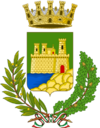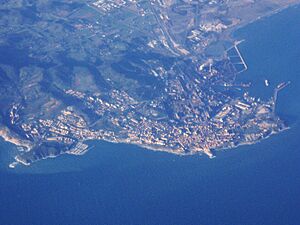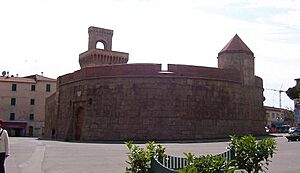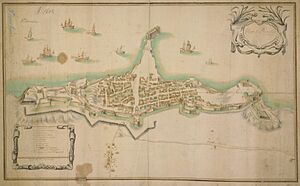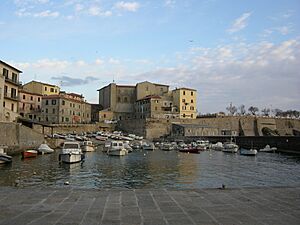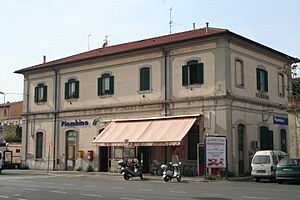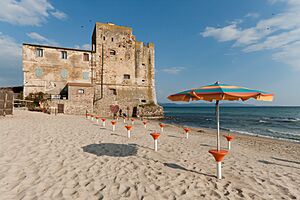Piombino facts for kids
Quick facts for kids
Piombino
|
||
|---|---|---|
| Comune di Piombino | ||
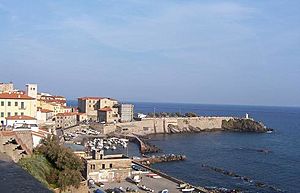
Panorama of Piombino
|
||
|
||
| Country | Italy | |
| Region | Toscana | |
| Province | Livorno (LI) | |
| Frazioni | Baratti, Colmata, Fiorentina, La Sdriscia, Populonia, Populonia Stazione, Riotorto | |
| Area | ||
| • Total | 129 km2 (50 sq mi) | |
| Elevation | 21 m (69 ft) | |
| Population
(January 2017)
|
||
| • Total | 34,041 | |
| • Density | 263.9/km2 (683.5/sq mi) | |
| Demonym(s) | Piombinesi | |
| Time zone | UTC+1 (CET) | |
| • Summer (DST) | UTC+2 (CEST) | |
| Postal code |
57025
|
|
| Dialing code | 0565 | |
| Patron saint | St Anastasia and St Augustine | |
Piombino is a historic Italian town located in the province of Livorno, within the Tuscany region. It has about 35,000 residents. The town sits where the Ligurian Sea meets the Tyrrhenian Sea. It is also directly across from Elba Island and on the northern edge of the Maremma area.
Piombino has a very old town center. It was once an important port for the Etruscans, an ancient civilization. Later, in the Middle Ages, it became a key port for the Republic of Pisa. Today, Piombino's port is still very busy. It handles both industrial goods and tourists. You can catch ferry boats here to Portoferraio on Elba Island and Olbia in Sardinia.
Contents
Where is Piombino Located?
Piombino is surrounded by several other towns. These include Campiglia Marittima, Follonica, San Vincenzo, and Suvereto. The town itself is divided into seven smaller areas called frazioni. These are Baratti, Colmata, Fiorentina, La Sdriscia, Populonia, Populonia Stazione, and Riotorto.
A Look Back at Piombino's Past
How Piombino Began
People have lived in the Piombino area for a very long time. During the time of the Etruscans, the main city nearby was Populonia. Today, Populonia is a small part of Piombino.
The name Piombino likely comes from Populino. This means "Small Populonia." Refugees probably gave this name to a small village. They had fled there after Greek pirates attacked Populonia in the 9th century. Piombino might have even been founded earlier, during the time of the Ostrogoth rule.
In 1022, a monastery called San Giustiniano was built here. This helped the area grow. More fishermen, sailors, and workers came to live there. In 1115, Piombino became part of the Republic of Pisa. It was Pisa's second most important port. A "Captain" was in charge of the town. During fights between Pisa and Genoa in the 12th and 13th centuries, Piombino was attacked many times. In 1248, the Captain Ugolino Arsopachi built the town's canals.
Piombino's Own Rulers
The Castle of Piombino stayed under Pisa's control for a while. Then, in 1399, Gerardo Appiani took control. He created an independent state called the Principality of Piombino. This state included Piombino and several islands in the Tuscan Archipelago. These islands were Elba, Pianosa, Montecristo, Capraia, Gorgona, and Giglio. The Appiani family ruled this area on and off until 1634.
In 1445, Rinaldo Orsini gained control of Piombino by marrying Caterina Appiani. From 1501 to 1503, Cesare Borgia took over the area. Later, Cosimo I de' Medici occupied Piombino during a war against Siena. In 1553 and 1555, a combined French and Ottoman fleet attacked Piombino. However, the town successfully defended itself. In 1557, a peace treaty brought the Appiani family back as rulers. But some parts, like Portoferraio, went to the Grand Duchy of Tuscany. The area around Orbetello became part of the State of the Presidi, controlled by Spain.
Becoming a Principality
In 1594, the Holy Roman Emperor Rudolf II made Piombino a principality. This meant it was a state ruled by a prince. Alessandro Appiani d'Aragona became the first Prince of Piombino.
In 1634, the Ludovisi family took over the title. This happened when Niccolò I married Polissena Appiani, the heiress, in 1632.
By 1708, the Boncompagni family began to rule the principality. Antonio I became the prince.
Piombino Joins Larger States
In 1801, Napoleon ended the principality. Piombino and its lands became part of the Kingdom of Etruria. In 1809, they were given to Napoleon's sister, Elisa Baciocchi. After Napoleon's final defeat, the Congress of Vienna decided that Piombino would join the Grand Duchy of Tuscany. Finally, in 1860, Piombino became part of the unified Kingdom of Italy.
Piombino During World War II
During World War II, Piombino played a key role in the early days of the Italian resistance. This happened right after Italy announced its surrender to the Allies in September 1943. On September 10, 1943, a small German fleet tried to enter Piombino's harbor. Port authorities refused them entry.
However, an Italian general, Cesare Maria De Vecchi, ordered the port to let the Germans in. Once the German forces landed, they started acting hostile. It became clear they wanted to take over the town. The local people wanted the Italian military to fight back. But another Italian general, Fortunato Perni, ordered his tanks to fire on the civilians to break up protests. General De Vecchi also forbade any action against the Germans.
Despite these orders, some junior officers took action. They started giving weapons to the people. Civilian volunteers joined Italian sailors and soldiers to defend the town. Fighting began at 9:15 PM on September 10. The German landing forces tried to occupy the town center. They were met by Italian coastal batteries, tanks, and armed civilians.
Italian tanks sank a German torpedo boat. Italian artillery also sank several other German boats and heavily damaged others. The German attack was pushed back. By the morning of September 11, 120 Germans were killed, and about 200-300 were captured. Italian casualties were 4 killed (two sailors, one Guardia di Finanza brigadier, and one civilian) and a dozen wounded.
Later that morning, General De Vecchi ordered the German prisoners to be released. Their weapons were given back to them. More protests broke out as Italian units were disbanded. Senior commanders fled the city. The city was surrendered to the Germans on September 12 and occupied. Many of the sailors, soldiers, and citizens who fought in Piombino retreated to the nearby woods. There, they formed some of the first partisan groups in the area. For their bravery, the town received a Gold Medal for Military Valour from President Carlo Azeglio Ciampi.
What to See in Piombino
Piombino has many interesting historical places to visit:
- Co-Cathedral of Sant'Antimo' (around 1377): This church was built by the Augustinians. It shows the Pisane-Gothic style, reminding us of Pisa's rule. Inside, you can see beautiful artworks by Andrea Guardi. These include a Baptismal Font. The back of the church has Renaissance tombs of the Appiani family. Guardi also designed the cloister in 1470.
- The Rivellino' (Walls Tower-Gate): This is the oldest monument in the city, built in 1212.
- The Chiesa della Misericordia' (early 13th century): This church holds a valuable 15th-century crucifix.
- The Cassero Pisano' (Castle): This castle has two parts. The Fortress was built under Cosimo I de' Medici in 1552–53. The Cassero (late 15th century) was used as a military jail until 1959.
- The Palazzo Comunale' (Town Hall): This building is mostly a modern rebuild of the old Palazzo degli Anziani (1435). In the Musters Hall, you can see portraits of the Princes of Piombino.
- Chapel of St. Anne: This is a notable Renaissance work by Guardi. Next to it is the Torre Civica (Town Tower), built in the 16th century.
- The Cisterna di Cittadella' (Citadel's Cistern): Also designed by Guardi. On its sides, you can see portraits of Jacopo III Appiani and his son and wife. These portraits were later damaged by order of Cesare Borgia.
- Casa delle Bifore' (House of the Mullioned Windows): This house dates back to the 1280s.
- The Natural Province Reserve Padule Orti Bottagone: This nature reserve was created in 1998. It is located near Torre del Sale.
Sister Cities
Piombino is twinned with:
Other Interesting Facts
Piombino has schools, a middle school (gymnasium), and high schools (lyceums). It also has churches, banks, parks, and public squares. In the area called Punta Falcone, there is an astronomical observatory. It was built in 1976.
East of Piombino, there used to be a large power station. It had two tall chimneys, each 195 meters (about 640 feet) high. This power station is now being taken apart. West of Piombino, there is the start of a special underwater power cable. This cable sends electricity to Corsica from the HVDC SACOI system.
See also
 In Spanish: Piombino para niños
In Spanish: Piombino para niños


